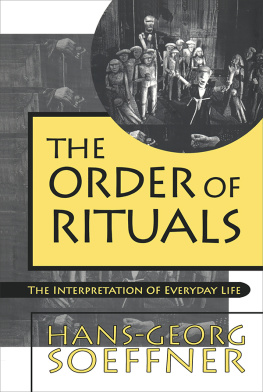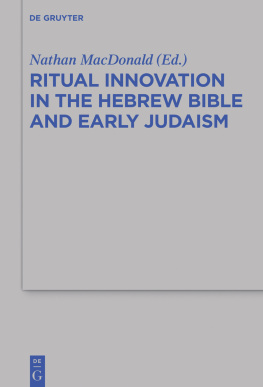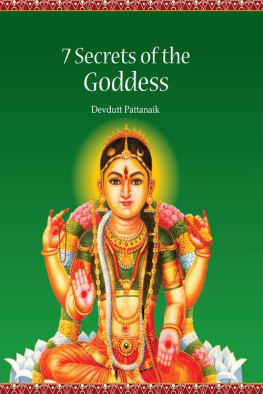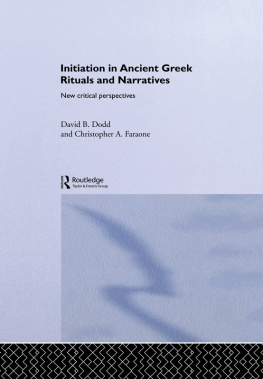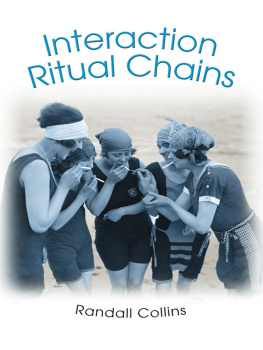Rituals of
MANHOOD
Male Initiation in
Papua New Guinea
edited by
Gilbert H. Herdt
with a new introduction by the editor
Originally published in 1982 by University of California Press Gilbert Herdt, Inc.
Published 1998 by Transaction Publishers
Published 2017 by Routledge
2 Park Square, Milton Park, Abingdon, Oxon 0X14 4RN
711 Third Avenue, New York, NY 10017, USA
Routledge is an imprint of the Taylor & Francis Group, an informa business
New material in this edition copyright 1998 by Taylor & Francis.
All rights reserved. No part of this book may be reprinted or reproduced or utilised in any form or by any electronic, mechanical, or other means, now known or hereafter invented, including photocopying and recording, or in any information storage or retrieval system, without permission in writing from the publishers.
Notice:
Product or corporate names may be trademarks or registered trademarks, and are used only for identification and explanation without intent to infringe.
Library of Congress Catalog Number: 97-27085
Library of Congress Cataloging-in-Publication Data
Rituals of manhood / edited by Gilbert H. Herdt; with a new introduction by the editor.
p. cm.
Originally published: Berkeley: University of California Press, 1982.
Includes bibliographical references and index.
ISBN 978-0-7658-0405-1
1. Puberty ritesPapua New Guinea. 2. Papua New GuineaSocial life and customs. I. Herdt, Gilbert M., 1949-
GN671.N5R55 1997
392.4dc21
97-27085
CIP
ISBN 13: 978-0-7658-0405-1 (pbk)
For Kenneth E. Mick Read,
a great ethnographer and pathfinder in New Guinea anthropology
Contents
Roger M. Keesing,
Gilbert H. Herdt,
Fitz John Porter Poole,
Edward L. Schieffelin,
Terence E. Hays and Patricia H. Hays,
Philip L. Newman and David J. Boyd,
Deborah B. Gewertz,
Donald F. Tuzin,
The making of men ceremonies documented in this volume provide some of the most dramatic and richly textured accounts of ritual passages known from the anthropology of the later twentieth century. When in an earlier time anthropologists and sociologists described collective initiation rituals, particularly through the lens of ahistorical and particular ethnographies, the political and gender aspects of these practices were seldom underscored, let alone theorized. Today, the power relationships of the body and domination and the social arenas of gender politics are widely regarding as critical to their cultural meaning and interpretation. Such is the degree of change and progress that has occurred in their symbolic understanding. In this volume a group of anthropologists who studied these matters provide first-hand descriptions of the ritual production of manhood.
These ritualized means of creating cultural masculinities in precolonial Melanesia were at once personal and political, symbolic and cosmological, as the late Roger Keesing observed below in his ground-breaking Introduction. Thus, the rites of manhood not only create a new personal meaning of the body for the individual initiate, but the ceremonies order politics and validate the social order with its gender divisions, attempting to create a seamless worldview and cultural reality. However, the contestations of the genders and the generations observed in this book make it clear that these ritual practices were more closely akin to systems of organized contradictions within these societies. The myths which accompanied them were in no small measure a means of ramifying but also of reconciling these contradictions (Tuzin 1997). But whether we emphasize ritual or myth in the making of men, it is now apparent that far more was involved in these symbolic systems than guessed at an earlier time in anthropological study. Such is the theme of this book, which opens an inquiry into the symbolic treatment of the body, religion, and the politics of gender hierarchies in New Guinea societies, past and present.
Ritual transitions have a long history of study. The rites of passage so well identified early in this century by Durkheim (1915) in his famous study of Australian Aborigines, and by Van Gennep (1960) in his cross-cultural structural analysis of far-ranging groups, were viewed as highly constitutive of the cycle of passages in human life, and the creation of the social person, both in the sacred and profane contexts of culture. These classical social ideas have taken on enduring value in socio-cultural theory and served as a source of insighteven in our secularizing post-modern society (Gellner 1992; Herdt 1992). Thus, while in New Guinea the rites of making men vary from place to place by means of language, local knowledge, and historical formation, they share in common the intentionality of instilling warriorhood, masculine identity, and higher social status in the change from boyhood to manhood, a point which Margaret Mead (1935) once suggested for Sepik River cultures, and K. E. Read (1965) affirmed for Highland societies. As Mead (1935) once noted, this gender and power transformation is not regarded as natural in local knowledge but is rather viewed as a painstaking achievement of male ritual. And hence we can observe similar transitions to adult manliness in many social formationsancient and modern, across civilizations large and smallaround the world.
These themes were at the heart of this book when it was first published fifteen years ago, and while much important work has emerged since that time, some of which has conflicted with the ideas and accounts of this volume, nevertheless this book remains unsurpassed as a cultural and historical documentation of manhood rituals in New Guinea. What have we learned since that time? What role can we assign to this book in posing the fundamental question: Why do men require ritual interventions and such prolonged social practices in their life cycles to achieve manhood in these societies? As Bruce Knauft (1993) has suggested in his significant study of South Coast New Guinea societies, the accounts from this part of the world are surely critical and relevant to rethinking the enterprise of comparative study in anthropology. Thus, the importance in debates regarding the link between ritual, gender identity, social exchange, historical domination, and the organization of culture areas is vital to the heritage of this book. Now, more than ever, there is a historical emphasis contained in the richly textured cultural traditions of ritual initiation to which the late Roger Keesing drew admirable attention in his original Introduction.
Of the work that was to follow, much has of course been added to what is known of ritual, gender, and power, in particular. The work of French anthropologist Maurice Godelier (1985) is particularly insightful here, for he has provided a rich and unique perspective on these issues from his long-term fieldwork among the Baruya of New Guinea. Godelier proposed the idea of great men in contrast to the received ideal type of big man. This was critical in social and cultural analysis because the great man is made in part by ritual and employs ritual initiations to create this social type. Likewise, the deconstructive efforts of Marilyn Stratherns (1988) studies of social exchange, gift-giving, the formation of persons and bodies, and the symbolic value of fluids and commodities are of immense import in reconceptualizing the ritual exchanges that are to be found in the book. In the work of both of these important scholars, ritual has taken on a new, somewhat more lasting and historical meaning, as well as a more central place in the understanding of society, culture, and the person.


